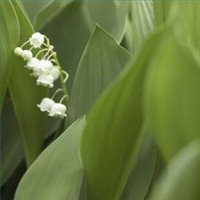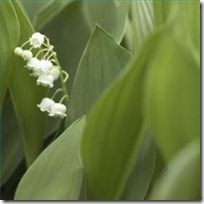Lily-of-the-Valley (Convallaria magalis), also known as May Lily, Our Lady’s Tears, Male Lily, Lily Constancy, Jacob’s Ladder and Ladder-to-Heaven is a shade-loving plant found in wooded areas with filtered sunshine and consistent moisture. The plant presents broad, rounded, deep green leaves and tiny, white bell-shaped flowers. The plant is attractive to bees and butterflies. Lily-of-the-Valley is easily propagated by digging up and dividing established clumps of the plant. The plant spreads by small rhizomes (called pips). Lily-of-the-Valley spreads fairly quickly. Flower beds should be thinned every five to seven years to avoid overcrowding.
Difficulty: Moderate
Instructions
Things You’ll Need:
- Garden gloves
- Organic compost
- Peat moss
- Aged manure
- Garden shovel
-
Dig up clumps of established Lily-of-the-Valley. In an established bed, dig up clumps every 1 to 2 feet. Fill in the holes with a mixture of equal parts potting soil, organic compost and sand. The newly created empty space will allow the plant to spread out and fill the bare spot. (If you do not have already established Lily-of-the-Valley, plants can be purchased from online vendors or home and garden supply stores.)
-
Divide the clump of Lily-of-the-Valley, gently separating the pips. Place the pips in a bucket of water to soak while you prepare a new area for transplanting.
-
Prepare a spot in the garden that affords filtered sunshine and good drainage. These plants prefer soil naturally enriched with decomposed leaves and humus. Cultivate the soil to a depth of 12 to inches, removing roots, rocks and debris. Work in a generous amount of organic compost, aged herbivore manure and peat moss. Water well.
-
Plant pips (bulbous roots) 2 inches under the soil. Lily-of-the-Valley grows well under pine trees as it appreciates a slightly acidic soil. Avoid areas of full sun. The plants will tolerate some morning sun, but will burn or dry out in open areas. Lily-of-the-Valley flourishes in U.S. hardiness zones 4 to 8.
-
Keep newly planted pips moist, but not soggy.
Tips & Warnings
-
Frequently mistaken for the real plant, false lily of the valley will only tolerate warm climates. False lily of the valley (Malanthemum dilatatum) grows well in semi-tropical to tropical climates where the plants receive filtered sunshine, lots of moisture and nutrient rich soil. The plant grows 5 to 10 inches above the ground, forming a thick, covering mat. False lily of the valley is an excellent ground cover for shaded or wooded areas. Plant away from traffic areas, in rock gardens or around water features.
-
Do not plant Lily-of-the-Valley if you have children or small pets. The leaves, roots and flowers of the plant are poisonous. Symptoms included blurred vision, headaches, upset stomach, diarrhea, depression, confusion, nausea and vomiting. Wear garden gloves when handling Lily-of-the-Valley. Wash hands and garden tools after working with the plant. Avoid mouth or eye contact.


Deprecated: strpos(): Passing null to parameter #1 ($haystack) of type string is deprecated in /home/agriviek8Qv/agriviet.net/public_html/wp-includes/comment-template.php on line 2522